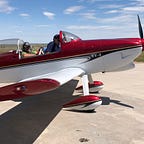Pan American Airways conquers the oceans
Pan American and flying boat era
While the Big Four were connecting the continental USA from coast to coast, Juan Trippe and Lindbergh were concentrating on the overseas routes. They persuaded the US government to grant them a virtual monopoly on international routes and set out to build Pan Am into a giant airline.
Their obsession with detail was legendary. Pan Am’s crews were highly trained in not only flying, but also mechanical repairs, usually starting life as technicians and working their way up. Unlike some European airlines, Pan Am flew at night, using celestial navigation on long over water routes. Many pilots were experienced merchant mariners, routinely landing at sea in poor weather and taxying into shore.
Pan Am built a strong network into Europe and South America, using the Sikorsky S-42 flying boats like the one above, before turning its attention to the Pacific.
The distances across the Pacific Ocean to China were immense — longer than any route flown at the time. Trippe had an aircraft specially designed for his needs by Boeing, the B-314. It was nicknamed the “China Clipper” to evoke memories of the clipper-ships that transported tea across the pacific in the earlier century.
But even the giant Boeing could not fly across non-stop. It needed several refueling stops on the way. In order to facilitate this, Trippe sent out a huge merchant ship full of equipment and supplies, to build suitable infrastructure on islands along the way. Wake and Midway Island were two of the isolated atolls that Pan Am turned into large islands capable of housing support crews and passengers en-route to China. This was done with the blessings of the US Government, which was determined to halt Japan’s dominance of the Pacific.
The Clippers raised the bar of luxurious air travel to a level that has not been surpassed since. With only First class available, the Clipper passengers enjoyed six course meals with silver cutlery freshly cooked by on-board chefs. The aircraft provided separate dressing rooms for male and female passengers, flat beds with linen sheets and came to epitomize the romance of luxurious air travel in the late 1930s.
The Europeans too were building large flying boats to serve the increasingly complicated route network built by the airlines. Britain took the lead with a series of such aircraft that established the route to distant Australia. The mail service alone proved to be so popular that a larger aircraft, from the Short factory, was built to allow greater payloads. The Short “Empire” class flying boats and their successor the Short Sunderland would do yeoman service before and during the Second World War. For a while, the largest Sunderland base in Asia was in Koggala, Ceylon. The most famous of the flying boats based there was of course the PBY Catalina, pictured below.
In the darkest days of the Second World War, with the Japanese occupying much of Asia, these Catalinas would fly non-stop from Koggala to Perth, still the world’s longest flight. Taking between 27 and 33 hours between the bases, the Qantas crews who flew them would see the sun rise twice in the course of one flight. Known as the “double sunrise” flights this provided a vital communication link and deserves greater recognition.
The Germans too built a number of very capable flying boats, as did the Japanese. The world’s largest flying boat of its time was the Dornier X, with twelve engines but the Dornier Wal, a twin-engine aircraft was built in larger numbers and served well into WW2.
After the war, the era of the flying boats gradually came to an end. The huge leaps in performance and range capability of land-based aircraft developed during the conflict, added to the numerous airfields built during the war effort, meant that the need to operate on water was no longer needed.
A few flying boats still exist, most famous being the Grumman family of aircraft, flown by Chalk’s Flying Service in Miami, shown here. Others versions of flying boats are used by fire-fighting crews.
The Chinese recently flew the Avic AG-600, a large four-engine amphibious aircraft and expect to start deliveries in the next few years, but this is a rare new development of a type that seems to have sadly had its day.
This is part of a series on the propliners of the 1950s and the slow transition to the jet age. It all began with the DC-3 of course, and my columns move through the other Douglas propliners, the Boeing 377, Lockheed’s Electras and the elegant Constellation. The Brabazon Committee which sparked such a wave of innovation in the UK with the Vickers Viscount, the Bristol Britannia and the ill-fated de Havilland Comet. Many other significant aircraft, such as Avro Canada’s innovative but aborted C-102 passenger jet and the Sud-Aviation Caravelle, which led us into the start of the Jet Age have columns too.
A few quirky segues I couldn’t resist: the ‘Double Sunrise’ flights between my two homelands Ceylon and Australia; the wonderful Carvairs and that very British habit of taking your car on holiday. I also had to write a paean to my beloved A380 and all my pilot friends in the Gulf as COVID ended that little dream.
Thanks for reading and I hope you enjoyed the series as much as I have relished writing them. My special thanks to my old friend, mentor, editor and repository of knowledge Roger Thiedeman, for all the encouragement and support throughout this project.
